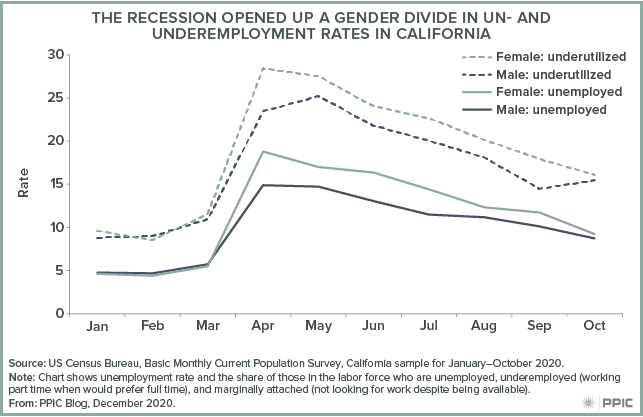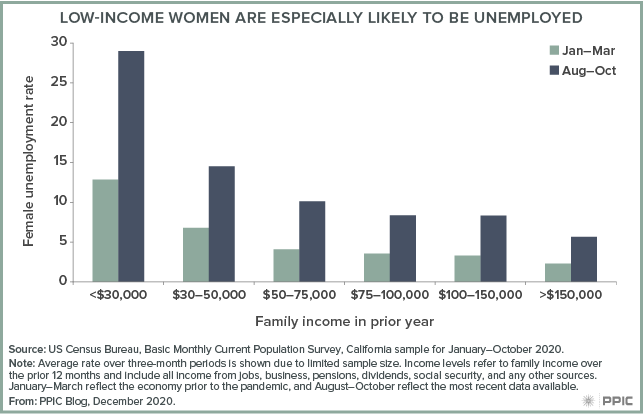This post is part of a blog series on income inequality and economic recovery. You can view all these posts on our poverty and inequality page.
Over the past 40 years, labor market gains among women have played a key role in boosting family incomes. But since the onset of the pandemic, women appear to have borne a larger decline in labor market activity—reflecting their higher likelihood of working in the most affected sectors and the extent to which women disproportionately provide care for children and aging family members. Once the economy begins to recover, investments in dependent care programs would help ensure that women can fully participate in the labor force.
Our new report shows that prior to the recession, men and women in the labor force had similar rates of unemployment, but by April the COVID-19 crisis had created a 3 percentage point gender gap in unemployment. A similar gap emerged in the share of men and women who were unemployed or “underutilized”—working part time when they would prefer to work full time or not looking for work despite being available. As of October, these gaps showed signs of narrowing, but more data are needed to determine if recent disparities will lead to longer-term “scarring” effects on women’s income and earnings trajectories.

The evidence to date suggests that most of the increase in un- and underemployment for women comes from the decline in opportunity for low-income women—if this trend continues, it will exacerbate income inequality. For example, between August and October the unemployment rate for women in families with income of $50,000 or less was 15% to 29%, compared to only 6% in families with income above $150,000. This is likely to further worsen the economic standing of low-income families overall.

Women of color have also been disproportionately affected, which may worsen longstanding racial income disparities. Latina, African American, and Asian American women experienced higher unemployment rates during the most severe part of the recession (18% to 19% between April and June) than white women (15%). These gaps narrowed somewhat in early fall (12% unemployment rate among women of color; 10% among white women).
The shift to remote K–12 schooling and the closure of child care centers have likely contributed to the decline in women’s labor market activity. Even before the pandemic, working mothers typically spent more time caring for children than working fathers, and the lack of affordable care options presented a barrier to work for many women.
Ensuring that women are able to fully engage in the workforce is essential. While the spread of the virus continues to constrain in-person care and K–12 schools remain mostly closed to in-person instruction, policy options to support women who are caregivers will be limited. But once in-person activities resume, policymakers should focus on shoring up the fiscal health of the dependent care sector by subsidizing or expanding family leave and existing programs like In-Home Support Services, the California State Preschool Program, Head Start, and Transitional Kindergarten.
Over the long term, investments in the dependent care sector can also be understood as a pathway for economic mobility—if policymakers prioritize improving providers’ wage levels. Moreover, expanding access to high-quality early childhood education will yield enduring benefits in the form of improved educational outcomes, higher earnings, and reduced crime. New investments are of course difficult in a constrained fiscal climate, but research shows benefits that accrue over the long run result in financial savings for the government.
This week, our blog is focusing on income inequality and economic recovery. Tomorrow, we investigate regional disparities in economic opportunity across California.








